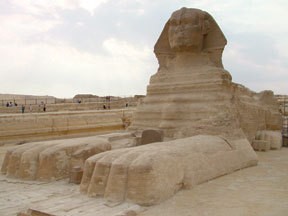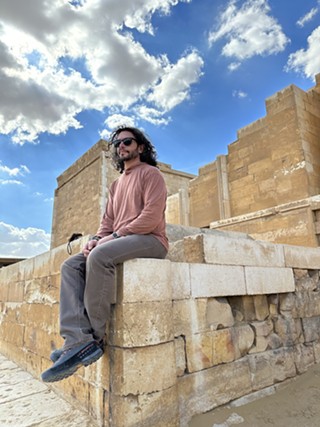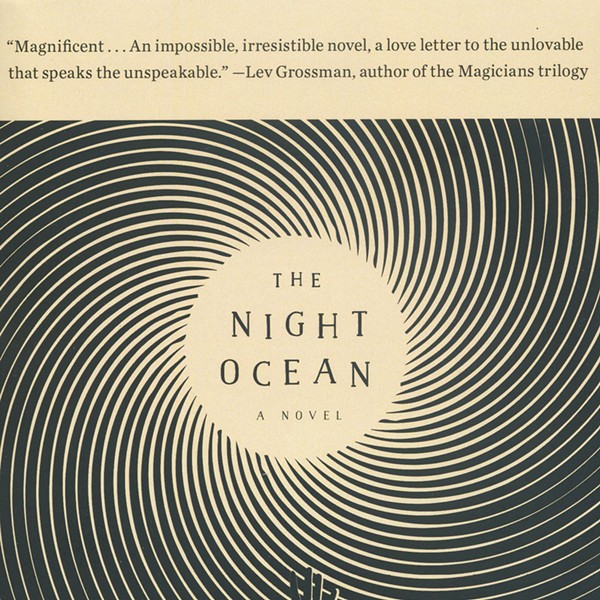It’s a pleasure to see you. Welcome back.
I thank you, Jason. Turkey was extremely enjoyable—hot, but cool.
Tell me what brought you to Turkey.
My geologist colleague, Robert Schoch, and I, more or less invited ourselves to this amazing place that’s been getting a certain amount of press, particularly in Europe—less so here—called Goebekli Tepe, which is in southeastern Turkey, some 40 or 50 miles north of the border with Syria. What’s interesting about this place: It’s, in my view, arguably one of the most spectacular archaeological finds of the last century, or really, in a sense, ever. It’s a hill, or it’s on a hill. It turns out that the hill is, as far as anyone knows, entirely artificial. The site is only about 5 percent excavated at the moment. The work’s being done by a very meticulous German archaeologist named Klaus Schmidt. What’s been found so far are four or five stone circles, like mini Stonehenges, each circle comprised of two massive, between 10 and 15-ton central stone pillars, and surrounded by two concentric circles of smaller pillars. The pillars themselves are decorated with exquisite high relief, the most difficult kind of carving. You have to carve away the rest of the pillar to leave whatever is carved jutting out from it. There are all kinds of animals—wild boar, foxes, cranes, an incredible lizard—and some of the pillars are anthropomorphic. They’re huge ,T-shaped slabs with arms and hands integrated into the form, as though they’re stone men.
How big is the site?
The inner circle is maybe 50 feet; the outer circle, maybe 60, something like that. The circles are placed very near to each other where they don’t quite interlock, but they’re very closely packed. It’s known that there are at least 22 subsites. Whether or not they’re all circles yet, nobody knows. But the most spectacular part of it, from our point of view, is the dating, which is done in part through carbon dating of material around these circles, which were completely, and deliberately, covered over around 8,000 BC.
How do we know that they were deliberately covered over?
Because the material that’s packed around them has to have been put there. It couldn’t have accumulated there. This is an archaeological conclusion backed up from a number of different points of view. The dating is done, some of it by carbon dating organic material within this fill, and some of it by geologists and geophysicists analyzing what are called microstalactites forming on the stone pillars themselves. When they get covered over, they get moist, and they form tiny crystals, and those can be dated; they contain organic material. This is the clincher: Schmidt dates those pillars to at least 10,000 BCE.
What’s the significance of the dating?
These dates, from an archaeological point of view, are absolutely shattering. They completely destroy the reigning paradigm of when and how sophisticated civilization began, because normally it’s thought that real civilization in our sense, sophisticated architecture—carving, painting, et cetera—dates from around 3,000 or 3,500 BCE; that it developed coevally in Egypt and Sumeria and China and probably in Mesoamerica. Before that, there were simple Neolithic settlements that produced rough pottery, combs, fish hooks, spears—little things like that. Before that, it’s all hunter-gatherers. This paradigm has been chipped away at over the last 15, 20 years or so, but there’s been nothing like a sophisticated site discovered.
But Goebekli Tepe is such a site?
Putting up a 10- or 15-ton block of stone, and carefully orienting it, is not the work of hunter-gatherers; or rather, these are very smart hunter-gatherers who can wrestle around 15-ton blocks of stone. And the carvings on them are spectacular. They’re reminiscent a bit of the Maya and also of much later but early Dynastic Egypt. They’re really elegant. But at 10,000 BCE! This means the current theories have got it all wrong. It was already highly developed at 10,000 BCE. Subsequently, for reasons that we absolutely don’t understand, civilization degenerated until it again rose with the onset of these major civilizations that we’re all familiar with—Sumeria, Egypt, China, et cetera.
In my reading about Goebekli Tepe, the assumptions were that these were hunter-gatherers, but they happened to build a nice temple.
[Laughs] Yeah, well…10- to 15-ton blocks of stone that they were bringing from a half mile away, up the hill.
It’s assumed that they were slave drivers, that this is the only way that they could have done it, and that the whole complex was a primitive temple of some kind.
Yes, it’s definitely a ceremonial site. Schoch and I believe that, in all likelihood, the animals and birds and figures that are carved there have an astronomical significance. This notion is based on that seminal book written in the late ‘60s by the two MIT historians of science, Giorgio de Santillana and Hertha von Dechend, called Hamlet’s Mill. Their main contention is that ancient myth and legend from around the world contains exact and extensive astronomical references. In other words, those much-maligned myths are not colorful attempts by primitives to account for the mysterious universe around them; rather, they are ingenious means of transmitting exact science through stories.
So what’s at stake here is an extraordinarily advanced civilization. They didn’t have pottery, as far as we know. They didn’t have a written language, as far as we know. But they could carve hard stone, in their own way, quite as well as Michelangelo or Rodin. These things are brilliant.
What do the carvings mean?
One of the lessons derived from Hamlet’s Mill is that when ancient legends refer to “gods,” those are planets, and when they talk about or refer to “animals,” they mean stars and constellations.
Schoch and I think that the astronomical context, if we can figure out what that is, may tell us why which animal is on which pillar and so on. It’s complicated. But as soon as you have astronomy involved, you know that even if people are hunting and gathering their food, they’re not primitives. They’re busy encoding astronomical information into a fairly sizable stone structure. It may be that before too long, somebody is going to start getting a sense of what their cosmology is like.
I’ve been studying and writing about symbolist Egypt for—what?—35, 40 years now. I developed the theory that the Great Sphinx was much, much older than it’s supposed to be, based upon a single observation made by the genius with the unpronounceable name R.A. Schwaller de Lubicz. He noted in one of his books that you can actually calculate the date that the ancient Egyptians ascribed to the beginnings of their own civilization. It’s somewhere around 34,000 or 36,000 BCE, which is unthinkable to an academic Egyptologist.
When Egyptologists read that, they think they’re just exaggerating?
They think they’re just nuts and that they’re inventing things, as if modern-day archaeologists or Egyptologists know more about ancient Egyptian history than the ancient Egyptians, which is typical of “quackademic” arrogance.
How does Goebekli Tepe support your view?
The main point of Goebekli Tepe, from our point of view, is the dating, because our work—backtracking, going back to Schwaller—is the observation that the Great Sphinx of Giza has been very severely weathered by rainwater, not by wind and sand. We presented our evidence at the Geological Society of America’s annual meeting back in ’91. It was unanimously accepted by the dozens of geologists attending our presentation but was met by fury from the Egyptologists and the archaeologists.
The controversy’s lurched on over all of these years without, let’s say, the smoking gun that we needed to establish the theory once and for all. But now Goebekli Tepe—that’s our smoking gun. One of the arguments always raised against us, was that it’s all hunter-gatherers back then, so how could the Sphinx be that much older than anything else we regard as sophisticated civilization? We had no major answer to that, certainly nothing visually exciting. Now we have it, since nobody is arguing about the dating of Goebekli Tepe.
What it means for civilization in general, this is a big question. It’s not just a quibble about dating or about chronology. Who really cares if it’s 10,000 BC E or 3,000 BCE? How does that affect our daily lives? What’s at stake actually is the story of civilization itself and what civilization actually entails. Because now, every time you turn on the television, or every time you read the front page of the newspaper, it’s clear that we’re living at the end of a civilization— certainly the end of something.
Now, our educational system inculcates in us the notion that we are the most advanced human beings that ever existed on the face of the Earth. No one has ever learned anything different at any contemporary Western school. We’re at the top of the evolutionary totem pole, with our hydrogen bombs and our Disneyland and our striped toothpaste and our Wal-Marts—this is the best we’ve ever done. That notion is the central dogma of what may be the silliest and most sinister religion yet invented: I call it the Church of Progress
Actually, we don’t even need Goebekli Tepe or the Sphinx to know better. You only have to walk into the cathedral at Chartres, for example, to know that this is not the case. There were periods in human history when somebody knew something that, from an emotional point of view and also actually from a technological point of view, is pretty staggering.
When this is pushed back into ancient Egypt and it’s understood through the symbolist interpretation for what it actually is, this whole scenario of everything going from primitive cavemen to hunter-gatherers to smart old us has to be thrown out the window. We see that extremely advanced beings lived way, way, way back when, and if we again extrapolate—we can’t do this yet with Goebekli Tepe—but if it’s fair to assume that whatever the spiritual doctrine that prevailed in Egypt and in China and in India, and all of these other places, was also prevalent when Goebekli Tepe went up in 10,000 BCE, then we take an entirely different view of our own human existence, of our past and also potentially of our future. So that instead of it being just a scholarly quibble, it is actually something that profoundly challenges the reigning philosophical view, which is solidly materialistic and rationalistic. In other words, you talk to a Darwinian devotee about the meaning of life, and they will laugh at you. But when you can point to these extraordinary civilizations, and realize that they go way, way back—that their bizarre gods and irrational legends actually represent the interplay of cosmic principles, that they enshrine exact science, and that it all dates from almost unimaginable antiquity—we realize that history is not what we’ve been taught. This can be a major element, at least potentially, for positive change. Everything can be changed, individually and collectively.
So there’s more than superstition here, there’s lost knowledge relating to both the cosmos and the psyche, and we need to find it.
Oh, yeah, but it’s actually already been done. It’s there. It’s there through the work of Schwaller de Lubicz, through Gurdjieff, through Hindu and Vedic philosophy, ancient China. It’s all there for us. It’s just not taught in schools, or in universities for that matter. These ancient great civilizations stand as models for us, actually. And in fact, apart from its incorrect chronology, our Church of Progress has grievously misrepresented history. In order to understand it, you can ignore most of the historians, all of whom have their own agendas, and simply look at what these ancient civilizations have produced. You can say, as a rule of thumb, that a civilization can be judged very objectively by what it does with its creative energies.
If you look at Egypt—which is particularly interesting since there’s so much of it left to experience—Egypt is a single-issue civilization. All of it— anyway, all that remains of it—is consecrated to the immortality of the soul. Rather different from our current culture.
Right. You look at where our own creative energy goes, probably 60 percent of it, if not more, goes into weapons of mass destruction or military something, one way or another. Probably another 30 or 35 percent goes into frivolity, into Hollywood and Disneyland. And maybe 8 or 10 percent actually goes into real science, medicine, things that are genuinely useful. But almost none of it is directed toward the development of the soul, the development of any spiritual discipline. From my point of view, without that, there is no civilization; it’s just progress, which I describe as “shiny barbarism.”
What do the ancient civilizations say is the purpose of life, and human life in particular?
Really, it’s probably best expressed in a contemporary context by Gurdjieff: his pupil J. G. Bennett called it The Theory of Reciprocal Maintenance. In the simplest terms: If we human beings don’t do our job (call it striving for immortality) the whole planet, and probably the solar system and all the rest, is affected one way or another. We have a job to do, and that job involves us acquiring a level of consciousness we’re not born with. If we look around us in the chaos of today, it is self-evident that the vast majority of us are unaware that such a possibility even exists. Unfortunately, that unawareness is particularly prevalent in many who call themselves “religious.”
So what can we learn from direct contact with these ancient cultures?
Two weeks in Egypt, and you understand it viscerally. Egypt is like sex: You can read all about it; you can even look at pictures. But until you experience it, you understand nothing. You do not have to be religious to understand the truth of “By their fruits you shall know them.” So two weeks in Egypt and, unless you are emotionally retarded and spiritually dyslexic, you came to understand what a true functioning civilization once was like. And you also understand that we have nothing remotely like it on the face of the Earth at the moment.
But once you’re there, bombarded day after day with one masterpiece after another, and once it’s explained via Schwaller’s “Symbolist” interpretation, it all makes a luminous sense. After a trip there, you know something that you might have suspected but, you’ve had it proved to you: We are more, much more than our material bodies, a chance conglomeration of molecules. The ancients understood this very well and built their civilizations upon that understanding. We are always taught that they were obsessed with death and trapped in a bizarre, superstitious, religious doctrine. But understood correctly, it was not so much religion as science, a “sacred” science of cosmic principles, directed toward the development and ultimate immortality of the soul.
Florence Nightingale visited Egypt back in 1849 and wrote perceptively back to her friends and family in England, “One wonders that people can come back from Egypt and live lives the way they lived them before.”
Join Chronogram and John Anthony West for a lecture and slide presentation on Egypt and Goebekli Tepe in August, at BEAHIVE in Kingston. Subscribe to the 8-Day-Week e-newsletter on www.chronogram.com for particulars.



















